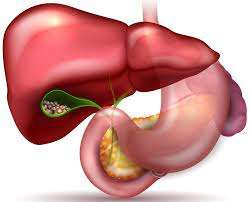Gall Bladder Stone

Ayurveda, the ancient system of medicine originating from India, offers a unique perspective on health and wellness. Among the various health concerns it addresses, gall bladder stones hold a significant place in Ayurvedic philosophy. Understanding Ayurveda’s viewpoint on gall bladder stones not only provides insights into prevention and treatment but also highlights the holistic approach the system takes towards overall well-being.
Introduction
The gall bladder is a small organ below the liver, connected to the digestive system. It holds a substance called bile, which is produced by the liver and helps in digesting food and neutralizing stomach acid. Gall bladder stones happen when these bile particles form hard stones inside the gall bladder. It’s not a common problem, and at first, it may not cause noticeable symptoms. However, as the stones grow larger, they can irritate the surrounding tissues, leading to pain.
Ayurvedic Perspective on Gall Bladder Stone
Ayurveda doesn’t specifically mention gall bladder stones. In Ayurveda, when a health issue isn’t directly described, it suggests using Ayurvedic diagnostic tools to understand the exact problem based on current dosha levels in the body. In this context, gall bladder stones are referred to as “Pitta Ashma” in the local language. “Ashma” means stone, and when stones are formed by Pitta, they are called Pitta Ashma, indicating gall bladder stones.
A. Causes.
- Excessive anger
- Excessive irritability
- Frequent intake of extreme hot, salty, spicy food
- Frequent fasting
- Frequent and excessive eating
- Irregular timing of diet
- Day time sleep
- Frequent stopping of natural urges like gases, stool, urine etc
- Obesity with increased cholesterol
- Infection
- Bile stasis (due to the pregnancy, operation like vagotomy etc)
- Hemolytic anemia
B. Symptoms.
1. Prodromal signs (Signs that occurs before actual starting of disease)
- Feeling of indigestion.
- Irritability
- Flatulence / Burps
- Acidity
2. signs and symptoms of gall bladder stones
- Frequent flatulence/ burps without any smell
- Reduced hunger
- Constipation
- Excessive anger
- Pain in abdomen
- Tenderness near liver are
- Mild fever
- Sometime jaundice
C. Ayurvedic Pathogenesis.
D. Ayurvedic Diagnosis
Ayurvedic diagnosis of gall bladder stones involves a comprehensive examination using various diagnostic tools. Ayurvedic practitioners assess the individual’s dosha levels, analyze the symptoms, and consider factors such as digestive health, lifestyle, and dietary habits. Pulse diagnosis (Nadi Pariksha) is commonly used to understand the imbalance of doshas, especially Pitta dosha associated with gall bladder issues. Additionally, Ayurvedic diagnosis may include examining the tongue, nails, and overall physical appearance to gain insights into the underlying imbalances contributing to gall bladder stone formation. This holistic approach aids in tailoring effective Ayurvedic treatments for the condition.
Ayurvedic Treatment Approaches
A. Dietary modifications.
1. Avoid Trigger Foods: Limit or avoid excessively hot, spicy, and oily foods, as well as those high in salt.
2. Balanced Diet: Emphasize a balanced and wholesome diet with a variety of fresh fruits, vegetables, whole grains, and lean proteins.
3. Hydration: Drink plenty of water throughout the day to support the proper flow of bile and prevent dehydration.
4. Herbal Infusions: Include herbal infusions like coriander or fennel tea to promote digestion and help balance Pitta.
B. Lifestyle Modification.
1. Regular Meals: Maintain a regular eating schedule with moderate portion sizes to aid digestion.
2. Physical Activity: Engage in regular, moderate exercise to promote overall well-being and support healthy digestion.
3. Stress Management: Practice stress-reducing techniques such as meditation, deep breathing, and yoga to minimize the impact of stress on digestion and Pitta balance.
4. Maintain a Healthy Weight: Manage weight through a balanced diet and regular exercise to prevent obesity-related factors contributing to gall bladder stone formation.
C. Herbal remedies.
1. Turmeric (Curcuma longa): Known for its anti-inflammatory properties, turmeric can help reduce inflammation and support gall bladder health.
2. Dandelion (Taraxacum officinale): Supports liver and gall bladder function, aiding in the elimination of toxins.
3. Boldo (Peumus boldus): Traditionally used to promote bile flow and support gall bladder health.
4. Artichoke (Cynara scolymus): Helps in digestion and may prevent the formation of gallstones.
5. Chanca Piedra (Phyllanthus niruri): Believed to break down and expel gallstones.
D. Panchakarma.
1. Virechana (Therapeutic Purgation): Aims to eliminate excess Pitta and toxins from the body, promoting healthy bile flow.
2. Basti (Enema Therapy): Anuvasana Basti (Oil Enema) and Niruha Basti (Decoction Enema) may be used to balance Pitta and improve digestive function.
3. Swedana (Herbal Steam Therapy): Promotes sweating and helps in detoxification.
FAQs
- Ayurveda recommends a balanced diet, avoiding excessive oily and spicy foods.
- Yes. Ayurvedic treatments can be effective, but individual responses may vary. Consultation with a qualified practitioner is advised.
- The timeline varies based on individual cases. Patience and consistent adherence to the treatment plan are essential.
- Ayurvedic treatments are generally safe when administered by qualified practitioners. However, individual sensitivities may exist.
Uniqueness of our therapies
At Arogya Mandir – Shri Siddhanath Ayurvedic Hospital, Miraj, we delve deeply into the ayurvedic examination of each patient. Utilizing noninvasive Ayurvedic diagnostic tools such as Ashtavidha Parikshan and Nadi Parikshan, we precisely determine the pathogenesis of the disease and then prescribe therapies tailored to the specific condition. This approach leads to expedited results.
Our therapies boast the following distinctive features:
– Tranquil and hygienic therapy rooms staffed with trained therapists in a positive environment.
– Selection of appropriate massage oil based on the patient’s Prakruti and the condition of the disease.
– Complimentary Prakruti and Dhatu Sarata examinations before the commencement of therapies.
– Authenticated procedures for each therapy.
– Judicious use of herbal medicines and instruments during the therapy sessions.
– Specialized rooms equipped with all facilities for inpatient care.
Feel free to share this article at no cost.
Copyright message – Dr. Prashant Chivate has published this article on drchivateayurved.org for informational purposes about diseases. Any other use of this article is strictly prohibited. All rights reserved.
